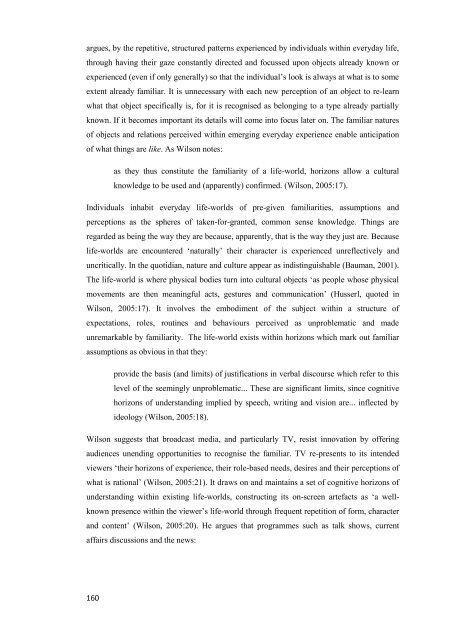A thesis submitted in partial fulfilment of - Etheses - Queen Margaret ...
A thesis submitted in partial fulfilment of - Etheses - Queen Margaret ...
A thesis submitted in partial fulfilment of - Etheses - Queen Margaret ...
You also want an ePaper? Increase the reach of your titles
YUMPU automatically turns print PDFs into web optimized ePapers that Google loves.
argues, by the repetitive, structured patterns experienced by <strong>in</strong>dividuals with<strong>in</strong> everyday life,<br />
through hav<strong>in</strong>g their gaze constantly directed and focussed upon objects already known or<br />
experienced (even if only generally) so that the <strong>in</strong>dividual‟s look is always at what is to some<br />
extent already familiar. It is unnecessary with each new perception <strong>of</strong> an object to re-learn<br />
what that object specifically is, for it is recognised as belong<strong>in</strong>g to a type already <strong>partial</strong>ly<br />
known. If it becomes important its details will come <strong>in</strong>to focus later on. The familiar natures<br />
<strong>of</strong> objects and relations perceived with<strong>in</strong> emerg<strong>in</strong>g everyday experience enable anticipation<br />
<strong>of</strong> what th<strong>in</strong>gs are like. As Wilson notes:<br />
160<br />
as they thus constitute the familiarity <strong>of</strong> a life-world, horizons allow a cultural<br />
knowledge to be used and (apparently) confirmed. (Wilson, 2005:17).<br />
Individuals <strong>in</strong>habit everyday life-worlds <strong>of</strong> pre-given familiarities, assumptions and<br />
perceptions as the spheres <strong>of</strong> taken-for-granted, common sense knowledge. Th<strong>in</strong>gs are<br />
regarded as be<strong>in</strong>g the way they are because, apparently, that is the way they just are. Because<br />
life-worlds are encountered „naturally‟ their character is experienced unreflectively and<br />
uncritically. In the quotidian, nature and culture appear as <strong>in</strong>dist<strong>in</strong>guishable (Bauman, 2001).<br />
The life-world is where physical bodies turn <strong>in</strong>to cultural objects „as people whose physical<br />
movements are then mean<strong>in</strong>gful acts, gestures and communication‟ (Husserl, quoted <strong>in</strong><br />
Wilson, 2005:17). It <strong>in</strong>volves the embodiment <strong>of</strong> the subject with<strong>in</strong> a structure <strong>of</strong><br />
expectations, roles, rout<strong>in</strong>es and behaviours perceived as unproblematic and made<br />
unremarkable by familiarity. The life-world exists with<strong>in</strong> horizons which mark out familiar<br />
assumptions as obvious <strong>in</strong> that they:<br />
provide the basis (and limits) <strong>of</strong> justifications <strong>in</strong> verbal discourse which refer to this<br />
level <strong>of</strong> the seem<strong>in</strong>gly unproblematic... These are significant limits, s<strong>in</strong>ce cognitive<br />
horizons <strong>of</strong> understand<strong>in</strong>g implied by speech, writ<strong>in</strong>g and vision are... <strong>in</strong>flected by<br />
ideology (Wilson, 2005:18).<br />
Wilson suggests that broadcast media, and particularly TV, resist <strong>in</strong>novation by <strong>of</strong>fer<strong>in</strong>g<br />
audiences unend<strong>in</strong>g opportunities to recognise the familiar. TV re-presents to its <strong>in</strong>tended<br />
viewers „their horizons <strong>of</strong> experience, their role-based needs, desires and their perceptions <strong>of</strong><br />
what is rational‟ (Wilson, 2005:21). It draws on and ma<strong>in</strong>ta<strong>in</strong>s a set <strong>of</strong> cognitive horizons <strong>of</strong><br />
understand<strong>in</strong>g with<strong>in</strong> exist<strong>in</strong>g life-worlds, construct<strong>in</strong>g its on-screen artefacts as „a well-<br />
known presence with<strong>in</strong> the viewer‟s life-world through frequent repetition <strong>of</strong> form, character<br />
and content‟ (Wilson, 2005:20). He argues that programmes such as talk shows, current<br />
affairs discussions and the news:




